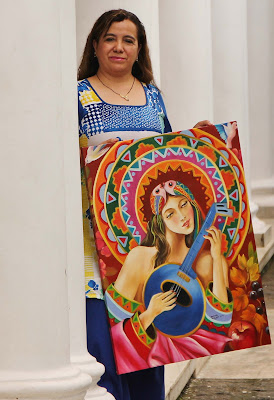Backgrounder:
The Brazilian artist Meri Amanda Calero could barely string two
words of English together. So I would type a sentence in English on
Google Translate and read out the Spanish version, since she is
originally from Ecuador. Then she would reply in broken English and
say a Spanish word, with emphasis. Which I would again put on
Translate and get the English version. It was fun, but exhausting,
for me, as well as local artist Manu, who sat in on the interview.
At
a recent exhibition, at Kochi, the Brazilian artist Meri Amanda
Calero showcased a couple of her works
Photo by Albin Mathew
By
Shevlin Sebastian
A
group of visitors crowded around the Brazilian artist Meri Amanda
Calero, as she pointed at her painting of an Indian holy man at the
Durbar Hall Gallery, Kochi.
The
oil on canvas showed a man, with an overflowing white beard, as well
as a thick moustache. The eyes and the lips seemed to hint at a
smile. A colourful orange turban adorned the head.
“I
met this man in Jaipur last year,” she says. “He was a wise man,
and deeply spiritual. But I don't know his name. We exchanged smiles
and held hands. And I felt inspired enough to do a painting.”
But
her second work is completely different. It is of her 15-year-old
niece, Sabrina who lives in Ecuador.
In
Sao Paulo, where Meri lives as a naturalised Brazilian, she earns her
living as a cardiologist. But every now and then she returns to her
home country of Ecuador to meet up with her family. And Sabrina
served as an inspiration.
The
image is of a young girl, with rouge on her cheeks, sensual red lips,
but with a distant look in her eyes, playing the mandolin. “She is
singing the pasillo, the national music of Ecuador,” says Meri.
“The songs are about heartbreaks and nostalgia for the past.”
Meri
got the opportunity to take part in the Kochi exhibition when he met
a Malayali artist, Manu, at an art event in Delhi last year. “I
invited Meri to take part in our 'Worldwide Art Movement' group
exhibition,” says Manu. “And Meri readily agreed.”
And,
on her first visit, she has a very high impression of Malayalis.
“They are happy, relaxed, and have a helping attitude,” she says.
“In Kerala and India, a lot of importance is given to art and
culture, unlike in Brazil.”
So,
Meri says, it is difficult to be a full-time artiste in Brazil. She
works on her art in the late evenings or the early mornings, after
her regular job. “And as and when I get the chance I come to
India,” she says.
Her
fascination with the country began when, as a teenager, in Quito, she
saw an exhibition of Indian artists. “The colours were so bright
and attractive,” says the 40-year-old. “I wanted to immediately
come to India.”
But
she could only do so in 2013. “I feel very happy when I am in
India,” she says. “This is my fifth visit. As an artiste, it is a
place that provides me with enormous inspiration.”
However,
Brazilian artistes are looking westwards for guidance. “In fact,
the biggest influence on them is the American artist Morgan
Weistling,” says Meri. “I tell them they should come to India, to
become better artistes. But nobody has followed my advice, as yet.”
(Sunday
Magazine, The New Indian Express, South India and Delhi)


yeezy boost 350
ReplyDeleteair jordan
moncler
off white
kyrie 6
kyrie irving shoes
bape hoodie
lebron james shoes
supreme
golden goose outlet
my blog Ysl replica handbags my blog Ysl replica bags weblink buy replica bags online
ReplyDelete